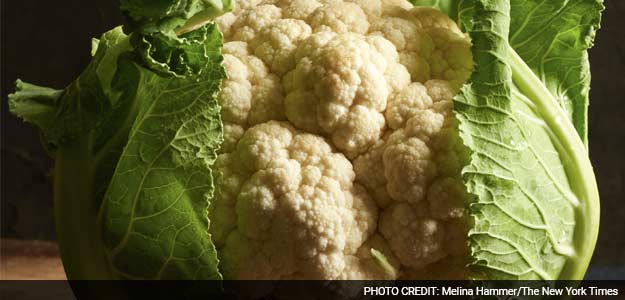For home cooks, it's all too easy to fall into a vegetable rut. Coming up with main courses for weeknight dinners is hard enough; very often, vegetables are the afterthought. Salad dumped out of a bag, or some out-of-season steamed asparagus or roasted brussels sprouts - these basics let us check the "green" box. But they are hardly inspiring.
January is the time of year to take a hard look at what's on our plates. This need not feel like a punishment. Some people quite enjoy fasting and purging, cutting back and cleansing. But I'm betting that New York Times Food readers don't fall into that category.
So instead of eating less, here's my annual proposition for better health: cook more. It is a fact that unless all you cook is bread pudding and bratwurst, homemade food overall has less fat, fewer processed ingredients, less sugar and (obviously) fewer hidden calories of all kinds.
As someone who spends much of her time investigating restaurant kitchens, I can report that at every level - from hushed, shiny temples that turn out foie gras and hand-torn pasta to flyblown street-meat carts - food made for you by professionals has far more butter and oil than you can possibly imagine.
There is butter whisked into Italian tomato sauce; grapeseed oil drizzled over the salad that's already dolloped with blue cheese dressing; cheese mixed into the oil-fried bread-crumb crust; mayonnaise in the "white sauce." (That, often, is what makes it taste so good.)
Your own home-cooked vegetables are the best antidote to all this. Even if the vegetable, like this whole cauliflower, is basted with olive oil and served with a rich, bright sauce made creamy with almonds, it is still a wholesome dish.
It makes a lovely light main course after a pasta intro or a gorgeous side dish for lamb or fish. It can lean Italian, Indian, French or Middle Eastern; it takes almost no effort; and it is adaptable to omnivores, vegetarians and vegans alike, making it a back-pocket recipe for the modern home cook.
The whole roasted cauliflower (along with the single giant beet and the overgrown carrot) recently surfaced as a favorite chef's trick. It is the centerpiece of menus at restaurants as far-flung as Los Angeles (Ford's Filling Station), New Orleans (Domenica) and beyond, to Paris and Vienna, where Israeli chef Eyal Shani has recently opened outposts of his Tel Aviv restaurant, Miznon.
His "baby cauliflower," now famous, blanched in salted water and then oiled and charred in a wood-fired oven, started the craze, which has been picked up by the likes of Jamie Oliver, Rachael Ray and Giada De Laurentiis.
It has also become one of the defining dishes of modern Israeli cooking. (One Vienna food blogger wrote in December, a few days before the opening of Miznon, "In just a few days I will finally be able to eat the famous cauliflower!")
My theory: One reason the dish has become so popular is that a whole cauliflower behaves very much like a roast of meat, in the oven and on the table. Its rough outer surface grabs onto flavor elements like fresh herbs, lemon juice and crushed spices. The whole head can be marinated or dry rubbed, basted and crusted and browned, but the inside remains silky and tender.
It makes an unbeatable visual impression, especially for a vegetable main course, which is so often a casserole or stew - delicious, yes, but visually underwhelming.
And it can be carved at the table, generating an appetizing air of anticipation and drama. For maximum impact, you could use baby cauliflowers and place a whole one in front of each person at the table.
Fortunately, it's almost preposterously easy to make at home. This recipe, from California-based chef and cooking teacher Joanne Weir, even eliminates the extra step of boiling the cauliflower.
"You don't need to do all that," Weir said. "Just keeping the vegetable whole also keeps it moist." Like most cooking teachers (and unlike most chefs), Weir is expert at developing recipes that minimize time, effort and mess for the home cook.
Given a choice between a recipe from an experienced teacher and a recipe from a chef, I always trust the teacher; the teacher knows what the questions, pitfalls and shortcuts for a home cook will be and writes the recipes accordingly.
Weir is eminently qualified as both: She trained in French cuisine with the famously formidable Madeleine Kamman, worked every station at Chez Panisse, has published a dozen cookbooks and teaches cooking classes around the Mediterranean.
The sauce presented here is her herbal riff on the classic Provencal anchoiade (ahn-shoy-AHD), a purée that can be as simple as garlic, anchovies and olive oil. The anchovies can be omitted to make the whole recipe vegetarian; replace the butter with olive oil, and it turns vegan. Additionally, tahini sauces, mustard sauces and vinaigrettes, all vegan, go particularly well with cauliflower.
She said she first encountered cauliflower served whole in France, where a few classic dishes like chou-fleurla polonaise present the whole vegetable, usually steamed or poached into blandness, and decorated with a rich, chunky sauce. But today's tastes have taken us away from those watery preparations (the cauliflower was said to have a "delicate" flavor) and toward the more concentrated, caramelized flavors produced by roasting.
Some vegetables have enough internal moisture to stay tender in a hot oven - but for those that do not, placing a bowl of water on the bottom of the oven floor creates a gentle steam that can prevent the dreaded leathery texture that afflicts some roasted vegetables.
This method works with any kind and color of whole cauliflower: pale orange, green and dark purple are becoming widely available. Try it with a head of spiky, psychedelic Romanesco. Or marinate it in yogurt, or olive oil and lemon juice. It is practically foolproof.
"I love this kind of recipe," Weir said. "It shows people the most important thing about cooking: It's not rocket science."
Whole Roasted Cauliflower With Almond-Herb Sauce Recipe
Time: About 2 hours
Yield: 2 main course servings, or 4 to 6 side dish servings
Ingredients:
For the cauliflower:
1 large cauliflower
Olive oil
Salt
For the sauce:
1/3 cup blanched almonds
6 to 10 anchovy fillets (optional)
2 garlic cloves, peeled
2 tablespoons unsalted butter, at room temperature
1/2 cup extra-virgin olive oil, plus extra for basting
2 teaspoons wine vinegar (white or red), more to taste
1/2 cup coarsely chopped parsley, mint, tarragon, cilantro or a combination
1/2 to 1 teaspoon red pepper flakes (optional)
Salt and ground black pepper
Preparation:
1. Heat the oven while you prepare the cauliflower: Place a heavy oven-proof skillet (a cast-iron skillet looks very nice) or a baking sheet in the oven and turn the heat to 375 degrees. Place a small pan of hot water on the floor of the oven, to create steam.
2. Break off and discard the outer leaves from the cauliflower. Cut off the bottom of the stem, and then use the tip of a small, sharp knife to cut off the leaves close to the stem. Carefully cut out the hard core of the cauliflower, near the bottom. Leave the main stem intact and make sure not to cut through any of the florets.
3. Rinse the cauliflower (leave the water clinging to the outside) and place on a work surface, core side up. Drizzle with olive oil and use your hands to rub over the cauliflower until evenly coated. Sprinkle with salt.
4. Place the cauliflower on the hot pan in the oven, core side down, and cook until very tender all the way through when pierced with a knife, at least 1 hour or up to 2 hours. During the cooking, baste 2 or 3 times with more olive oil. It should brown nicely. If you have a convection feature, use it toward the end of baking to brown the crust.
5. Make the sauce: In a small frying pan, toast nuts over low heat, shaking often, just until golden and fragrant. Set aside to cool.
6. Soak anchovies, if using, for 5 minutes in cool water. Rinse and set aside on paper towels.
7. In a food processor, combine almonds, anchovies, garlic and butter and pulse until smooth. Mix in oil, then vinegar. Mix in herbs and red pepper flakes, if using. Season to taste with salt and pepper. Set aside.
8. When cauliflower is tender, remove from the oven. (If desired, run it briefly under the broiler first to brown the surface; there is no need to do this if you used convection.)
9. Serve cauliflower in the skillet or from a serving plate. Cut into wedges and spoon sauce around each wedge.
Garlic Tahini Sauce
Time: 10 minutes
Yield: 1 scant cup
Ingredients:
1 garlic clove, cut in half, green shoots removed
Salt to taste
1/3 cup sesame tahini
2 to 4 tablespoons fresh lemon juice (more to taste)
Aleppo pepper or red pepper flakes for sprinkling
Preparation:
1. In a mortar and pestle, mash the garlic clove to a purée with a generous pinch of salt.
2. Transfer to a bowl and whisk in the sesame tahini. Whisk in the lemon juice, beginning with the smaller amount. The mixture will stiffen up.
3. Gradually whisk in up to 1/3 cup water, until the sauce has the consistency of thick cream or runny yogurt. Taste and adjust salt. Sprinkle in pepper.
Tip: The sauce will keep in the refrigerator for a few days but is best made just ahead, because the taste of garlic grows stronger over time.
And to Drink ...
Roasted cauliflower has a naturally savory character that can be versatile with wine. When it's simply roasted with olive oil or butter, I'd be tempted to reach for a white, something assertive and rich but not extravagantly fruity. A good Meursault or cool-climate chardonnay comes to mind, as does a Savennires, especially with the combination of herbs in the recipe. Or you could try an Austrian white, either a gruner veltliner or a riesling, particularly the weightier smaragds from the Wachau region. You could try a traditionally made white Rioja, or even some of the better Portuguese whites. Add the umami explosion that comes from anchovies, and, while the whites would still be fine, I also think of earthy reds like cabernet franc from the Loire Valley or Austrian blaufrnkisch and possibly lighter syrahs from the northern Rhone Valley or California.- ERIC ASIMOV© 2016 New York Times News Service










